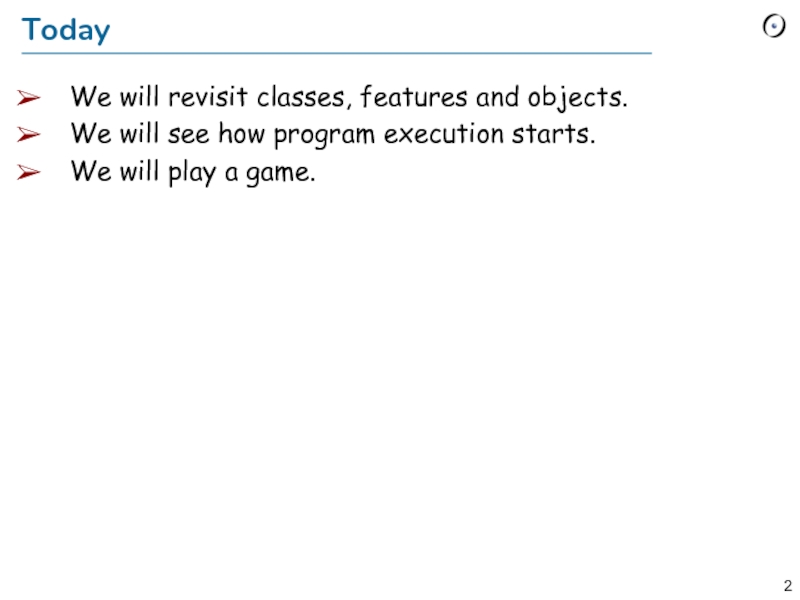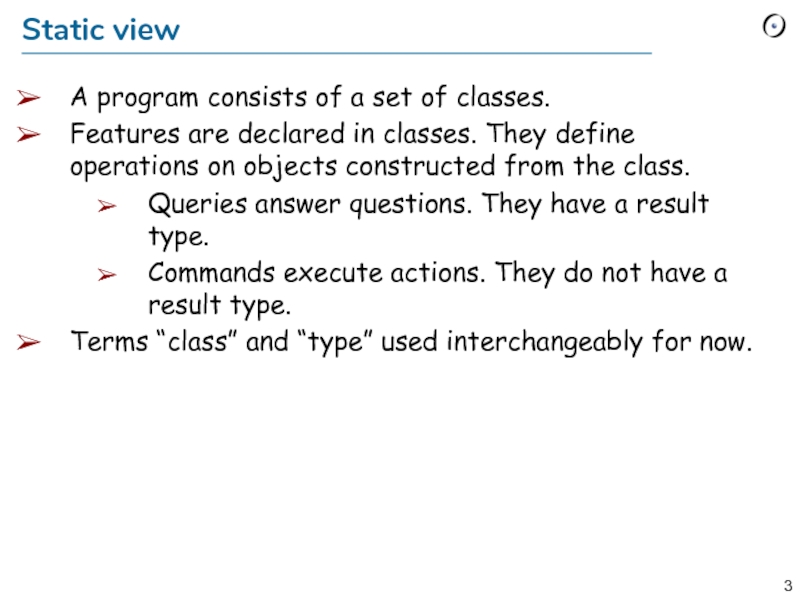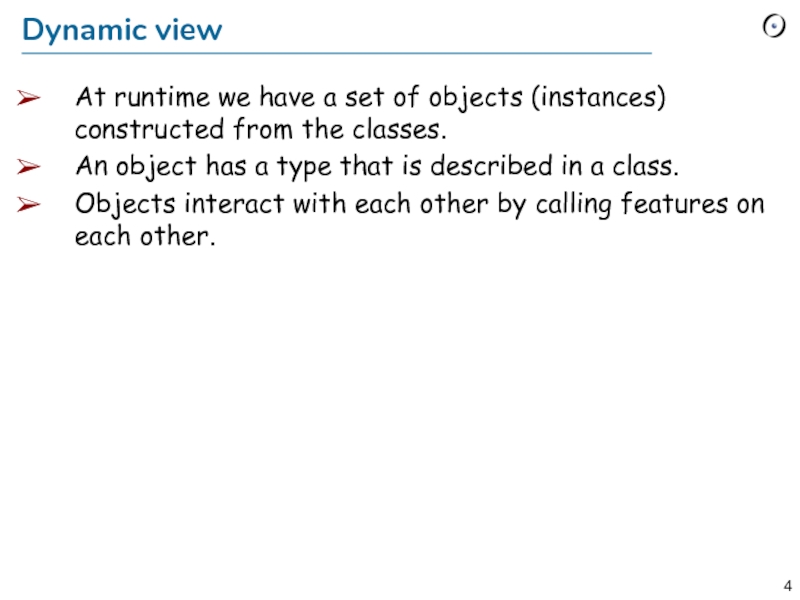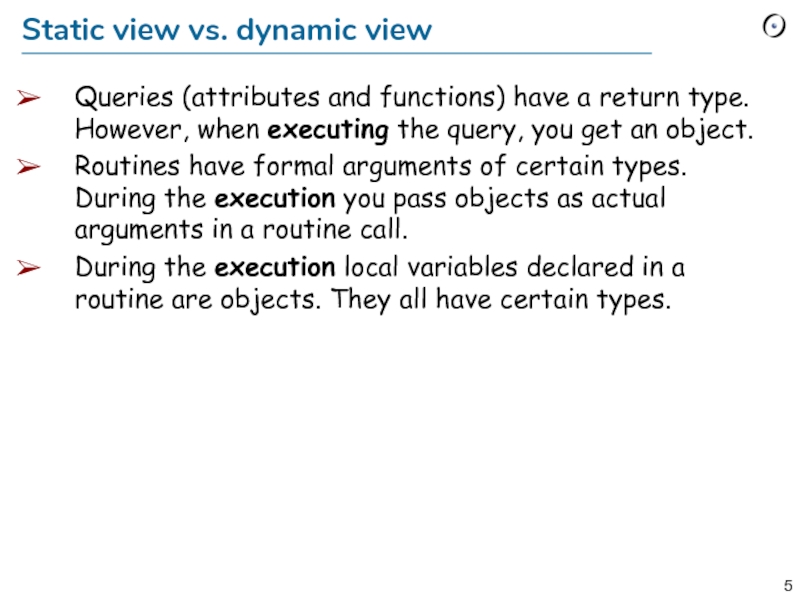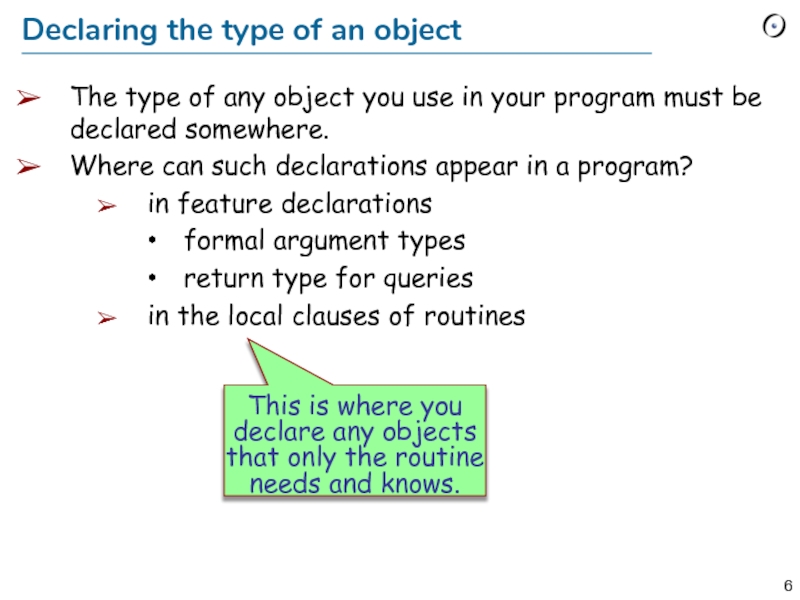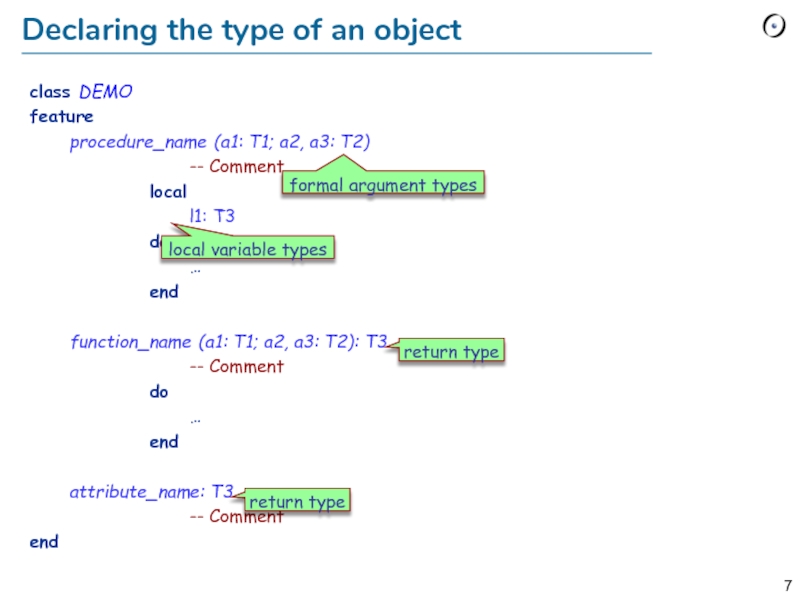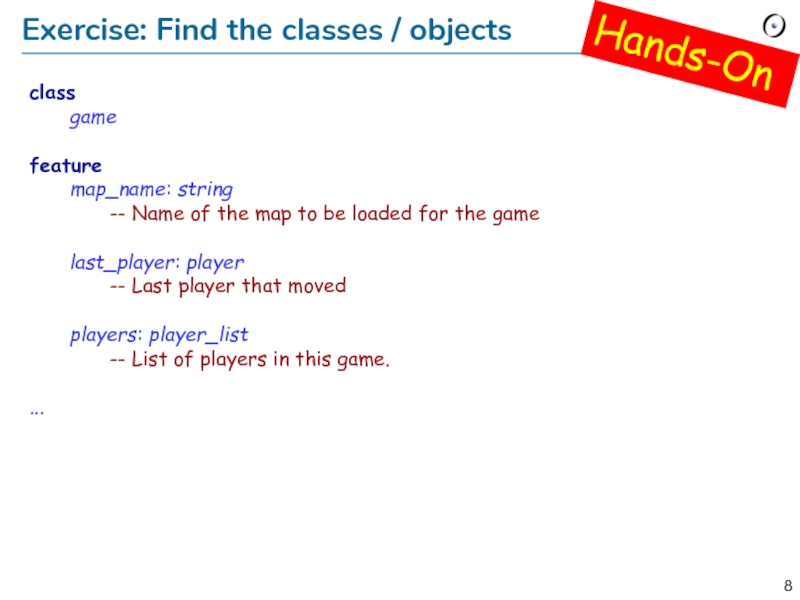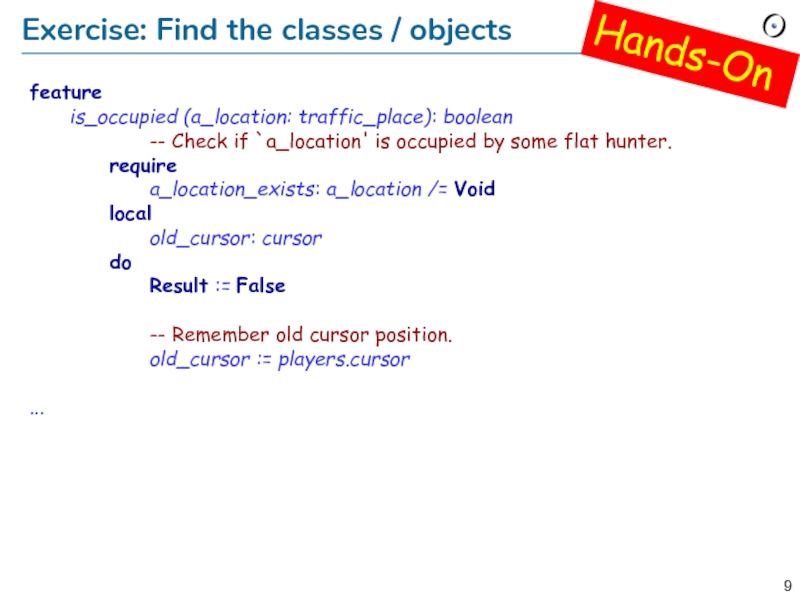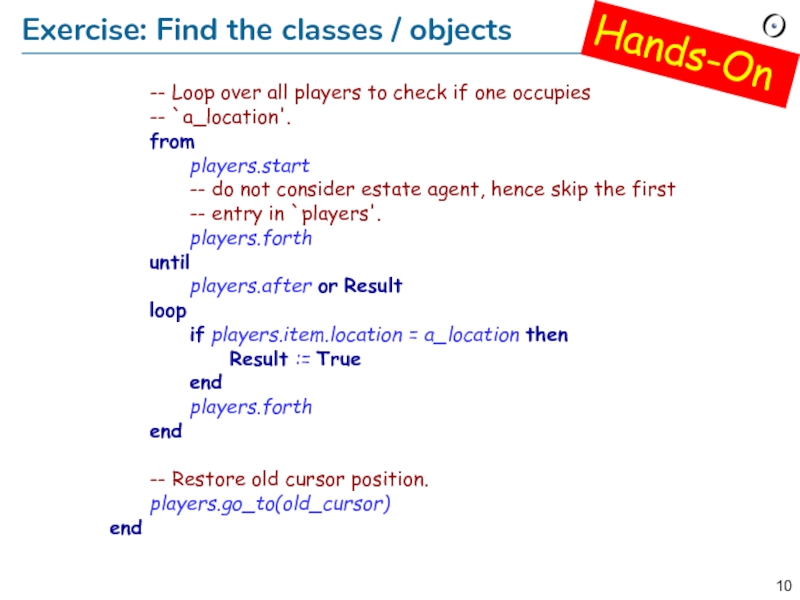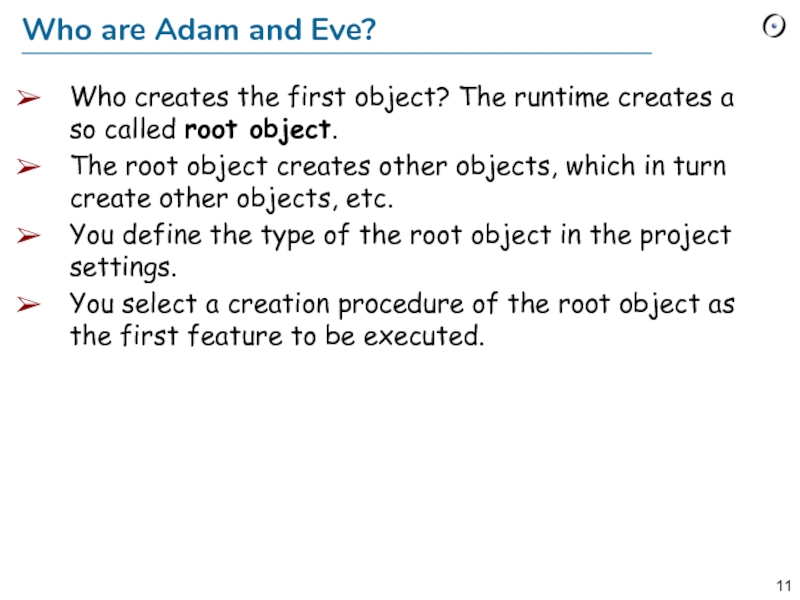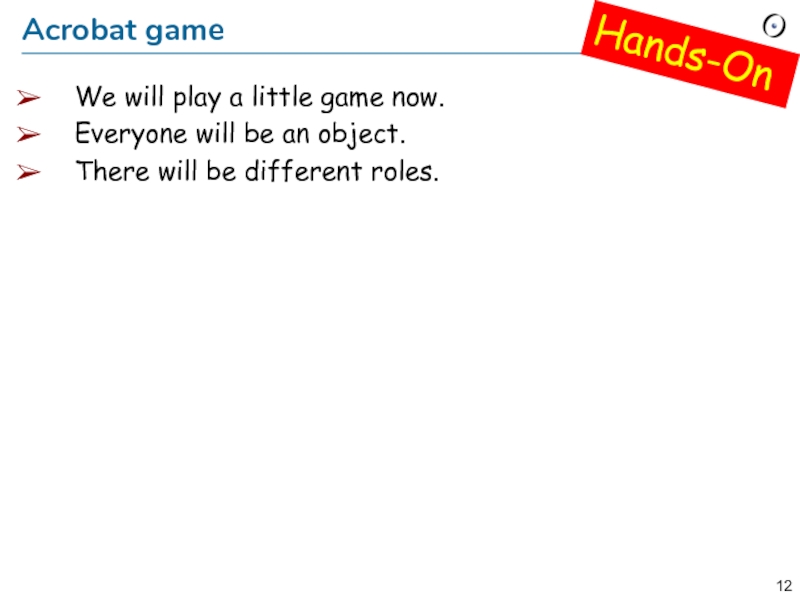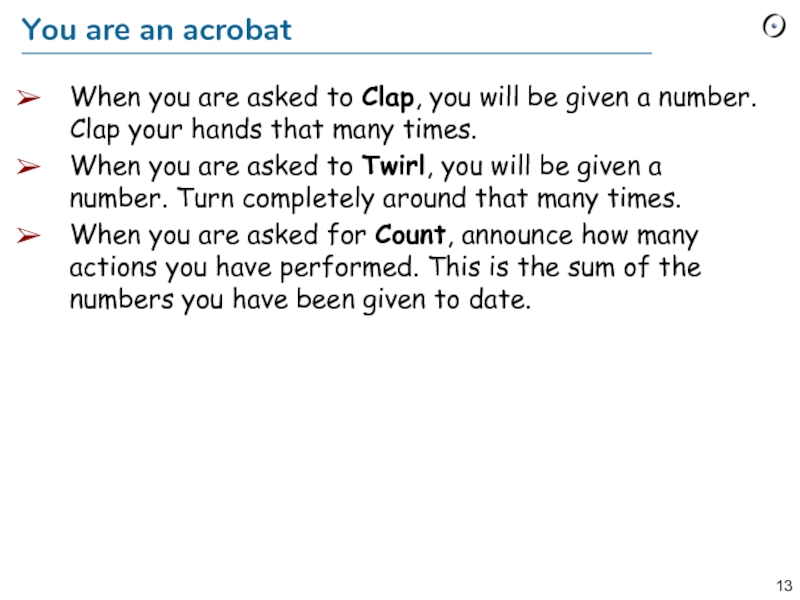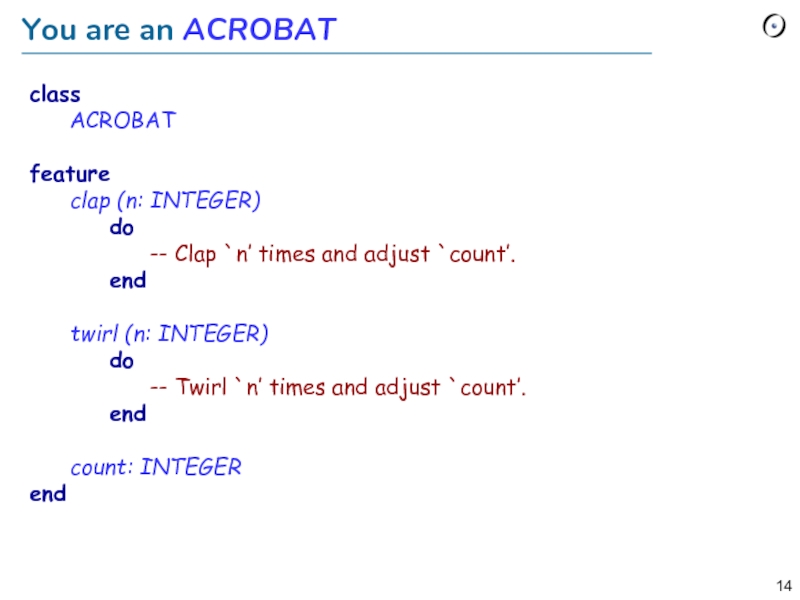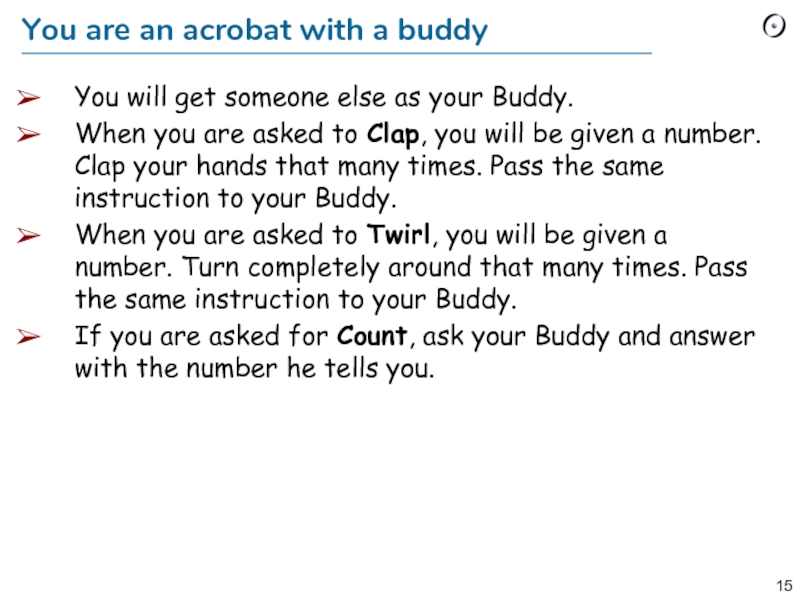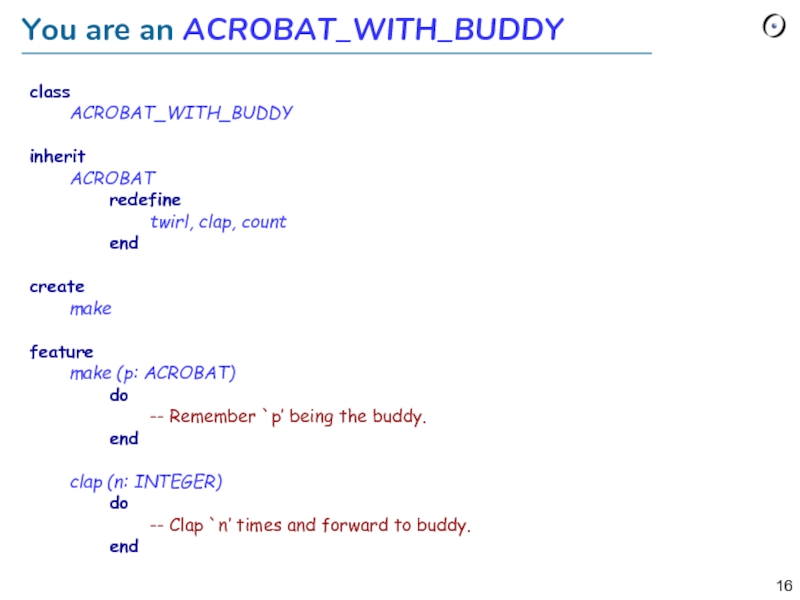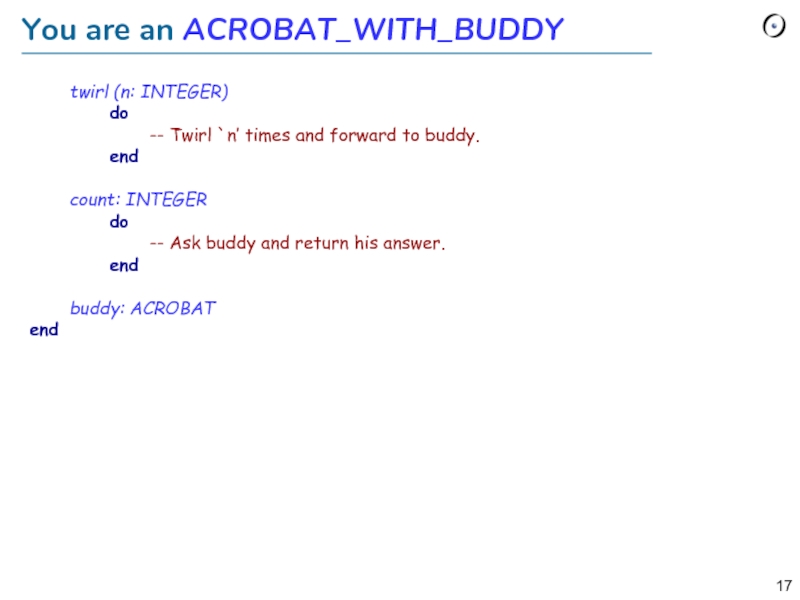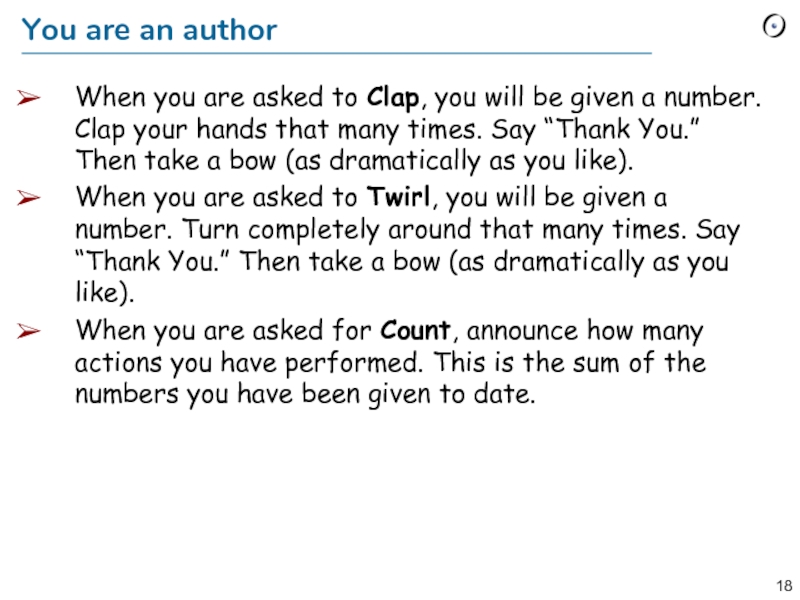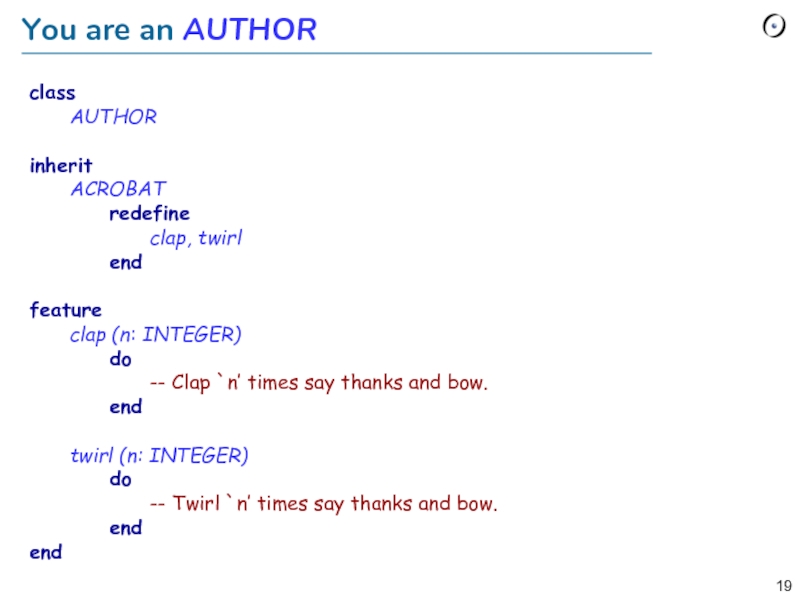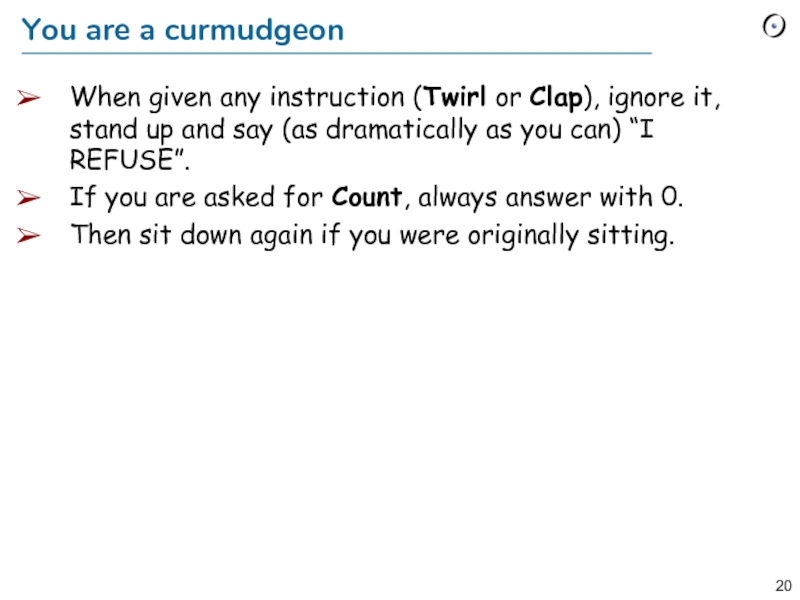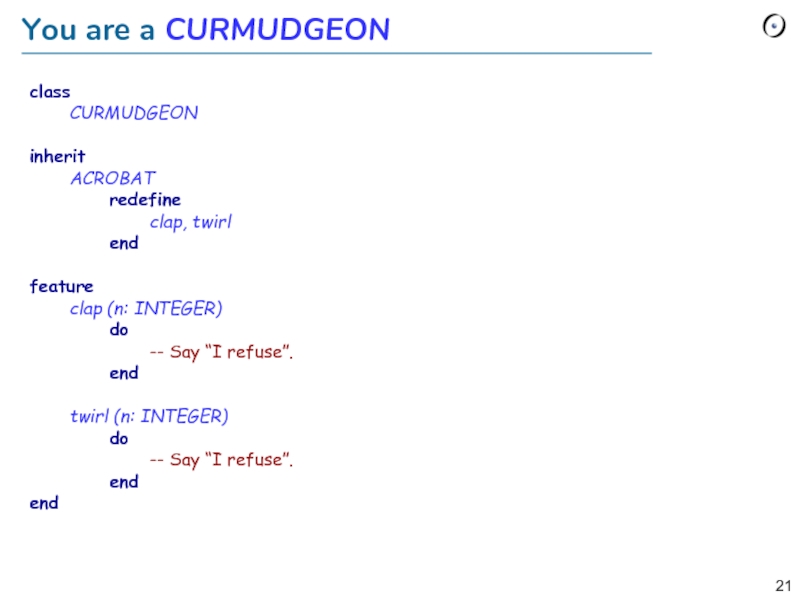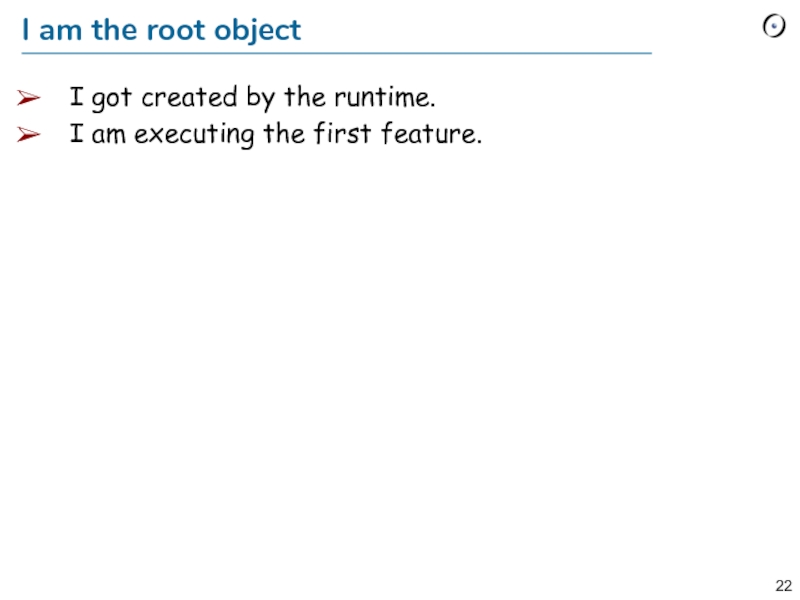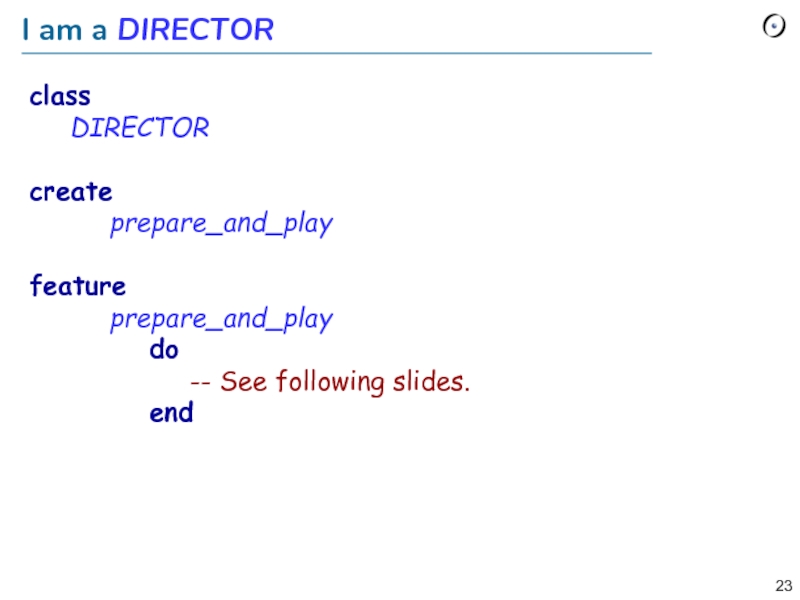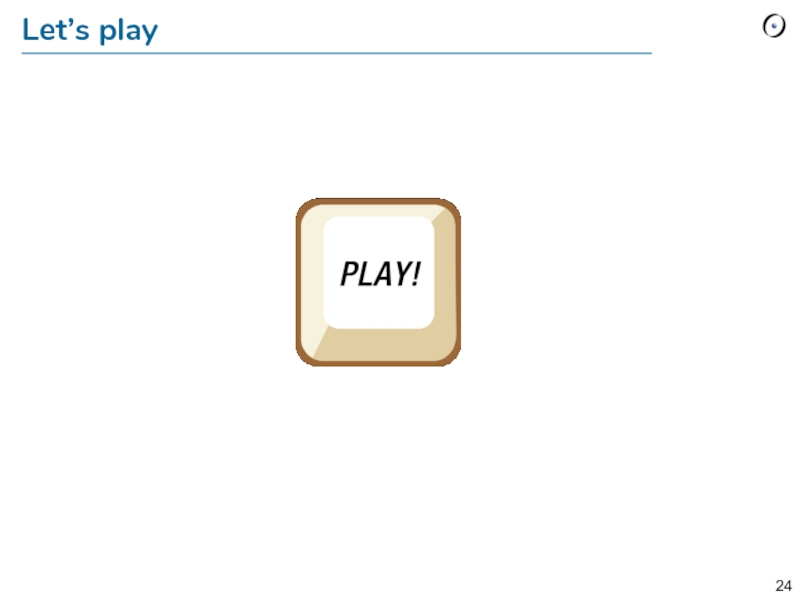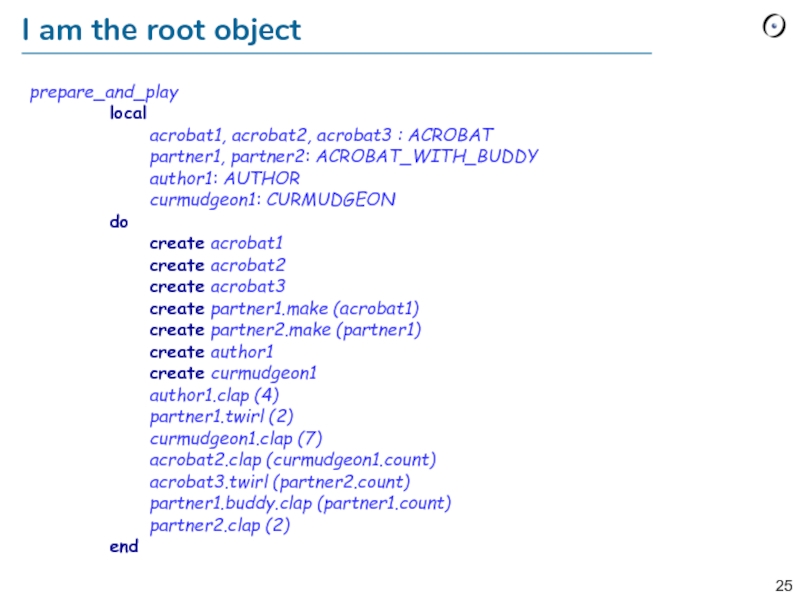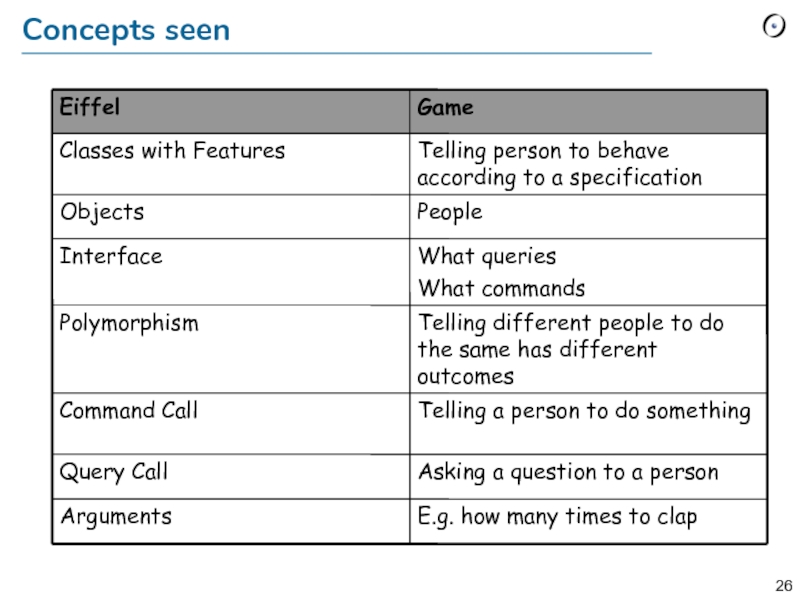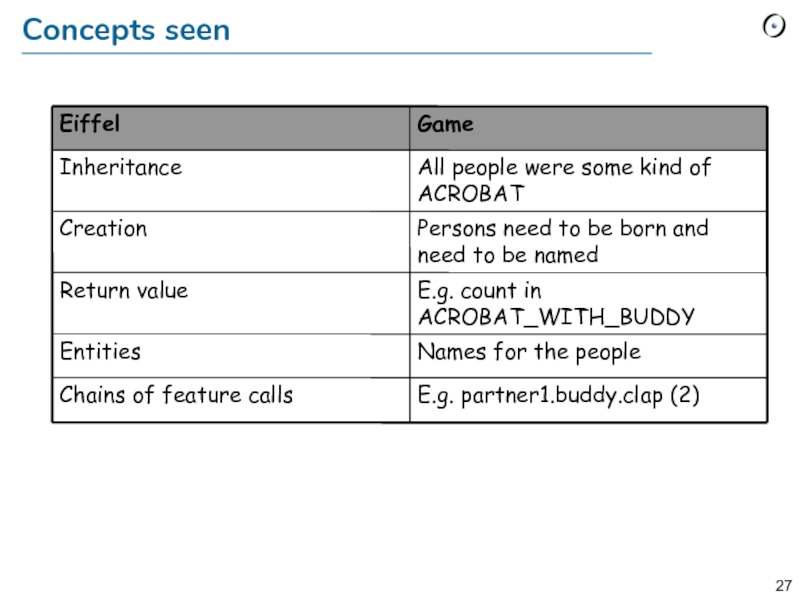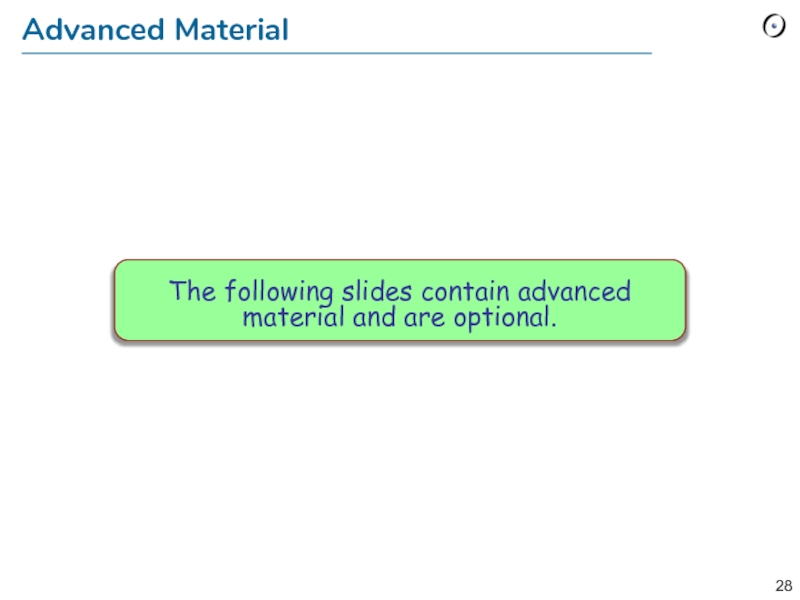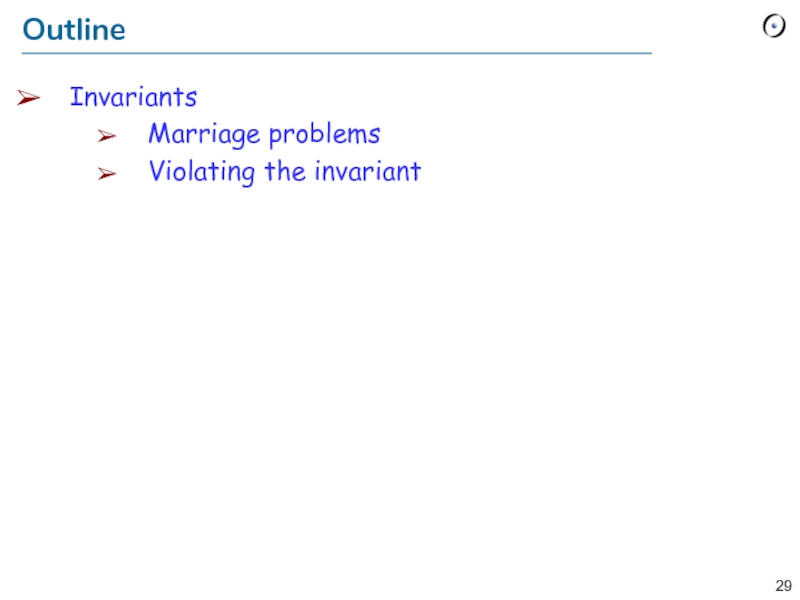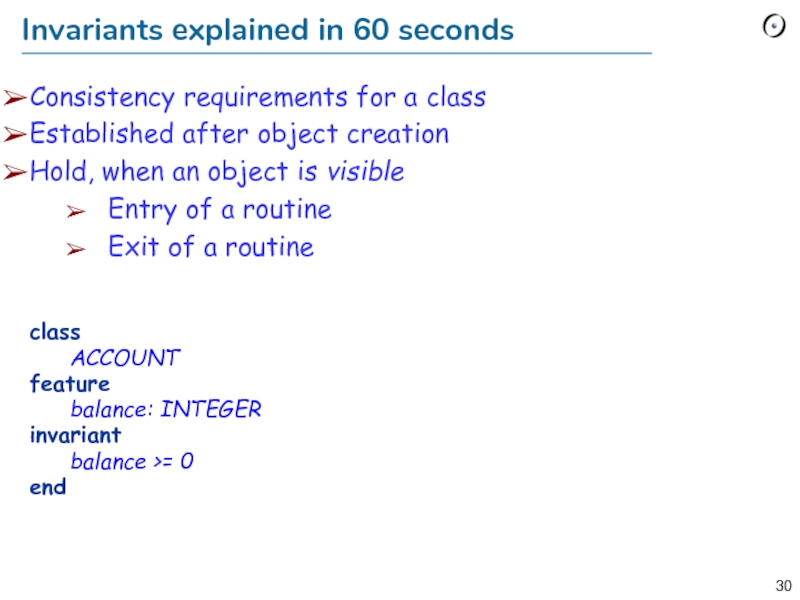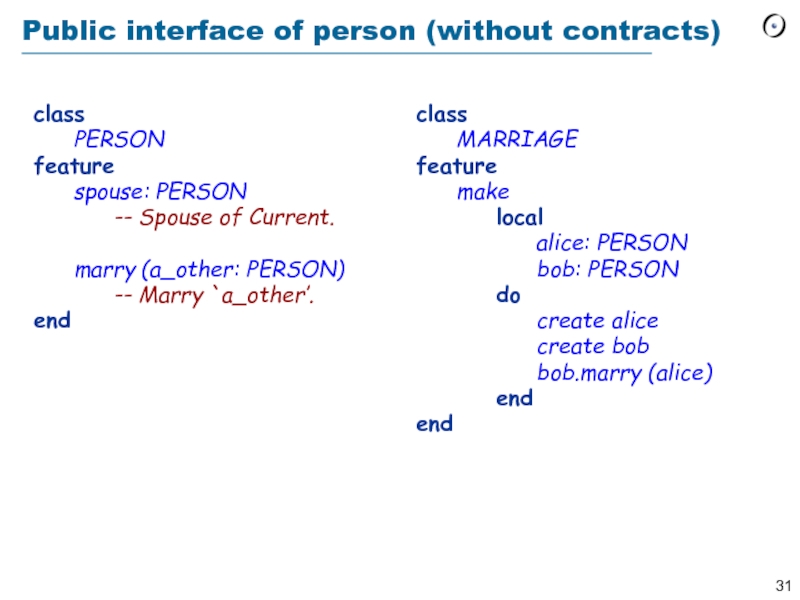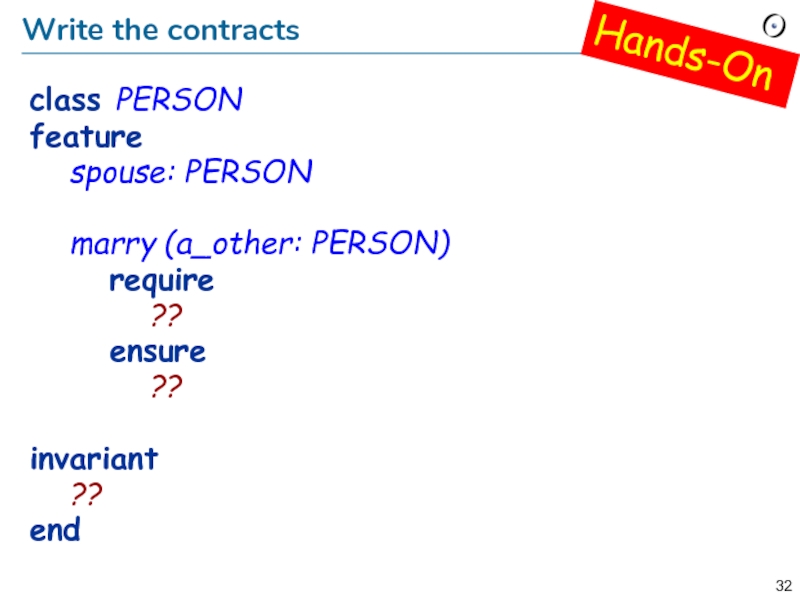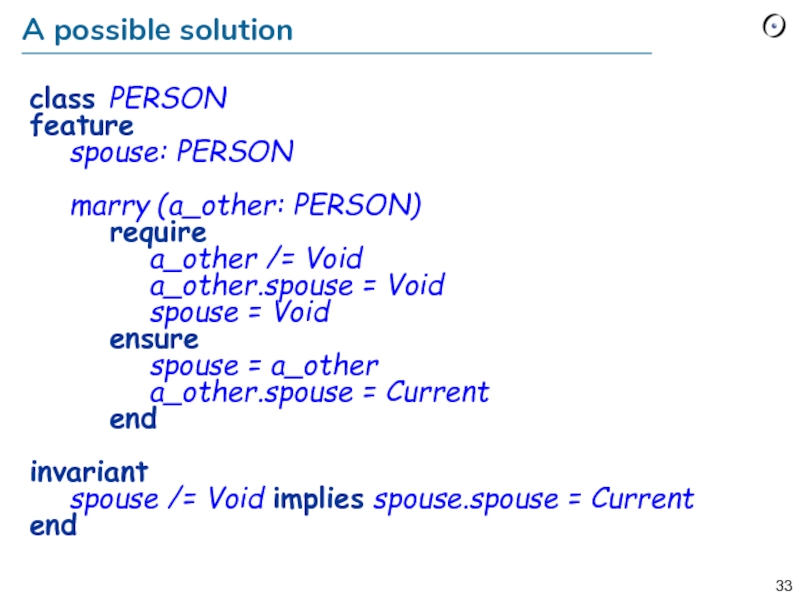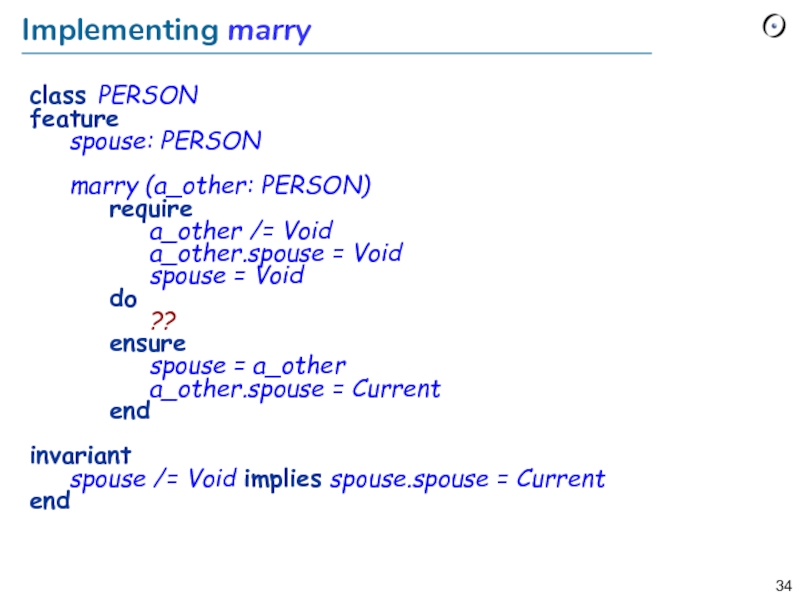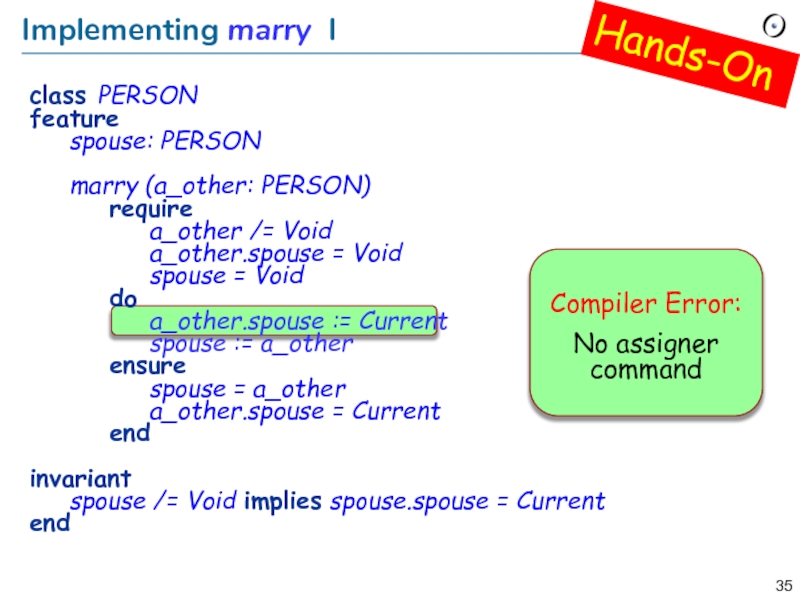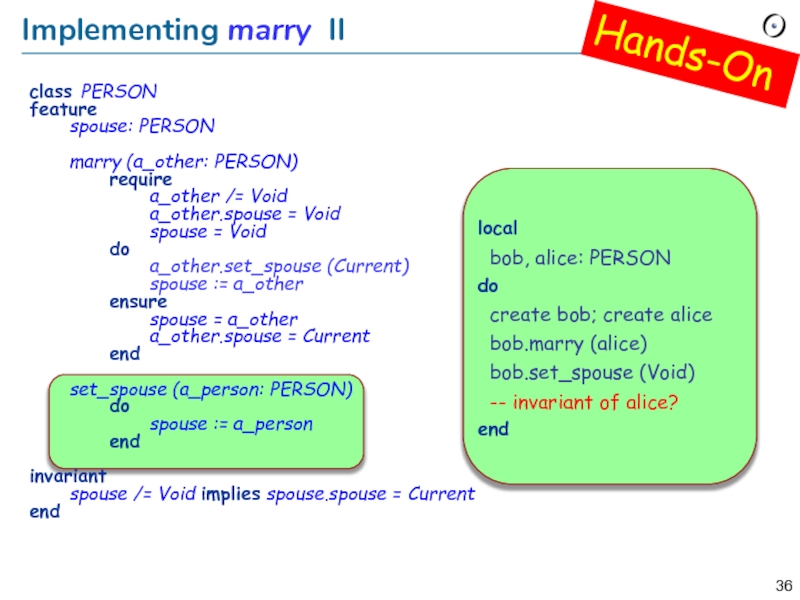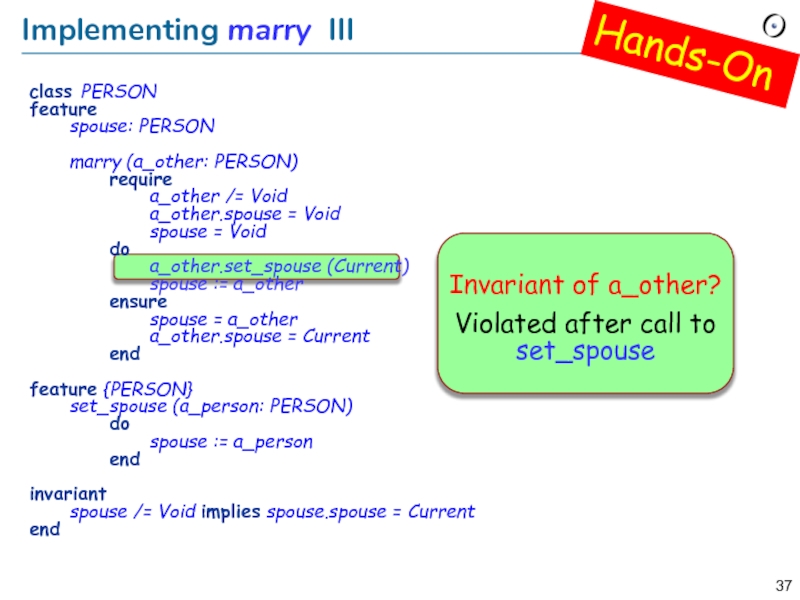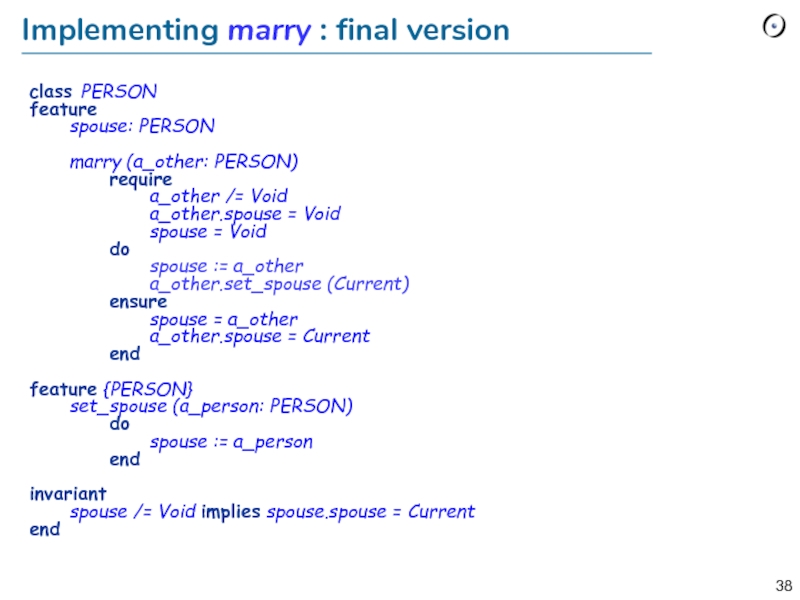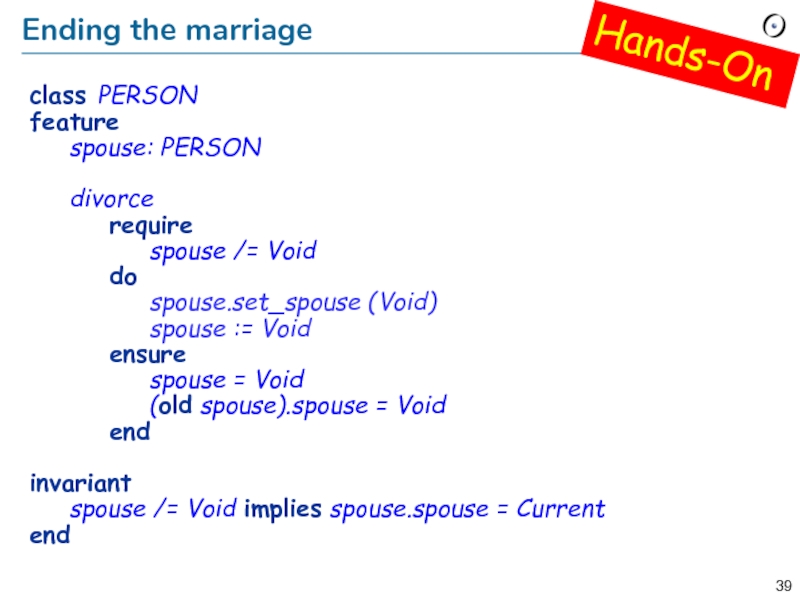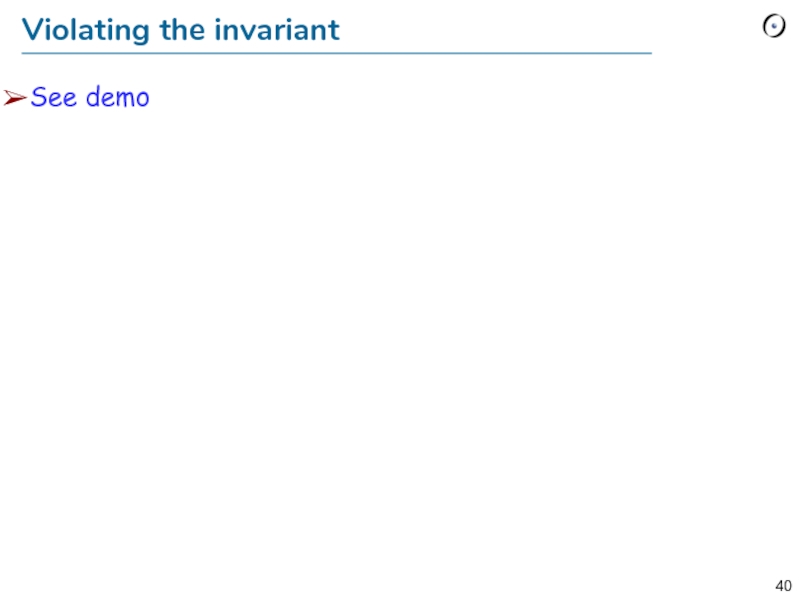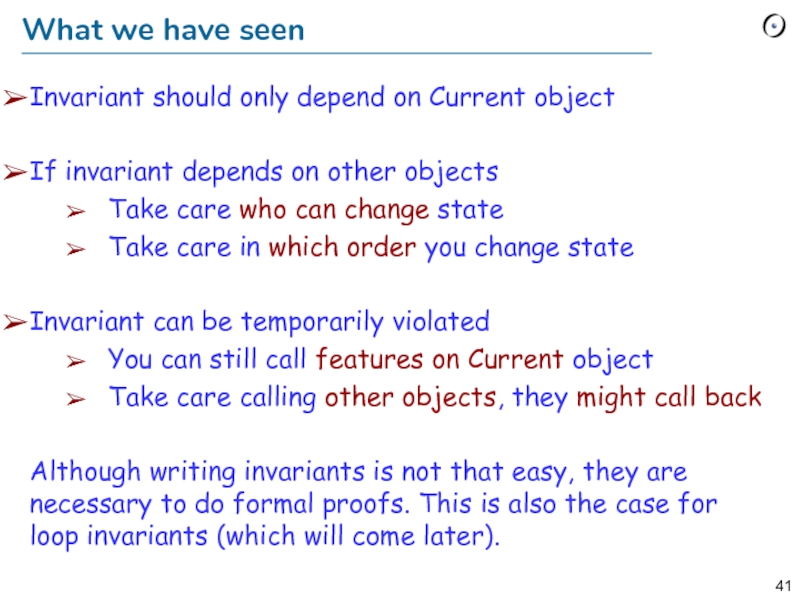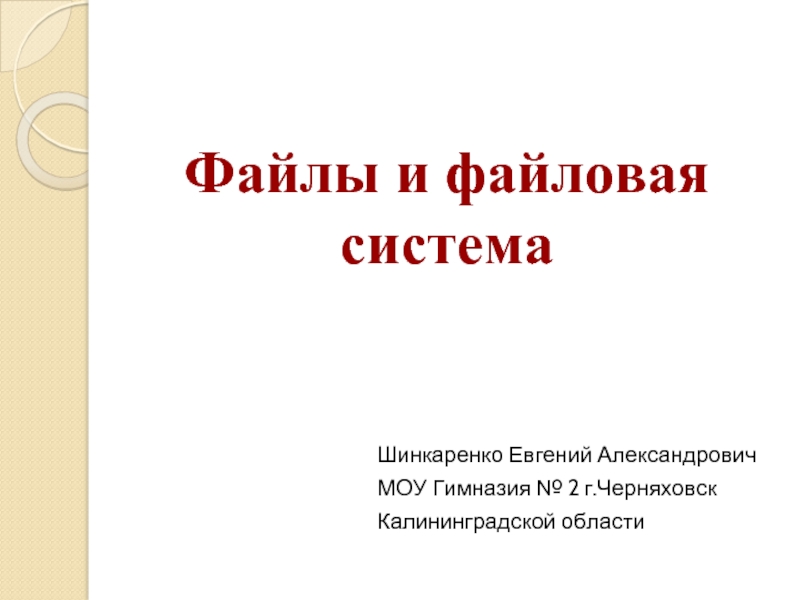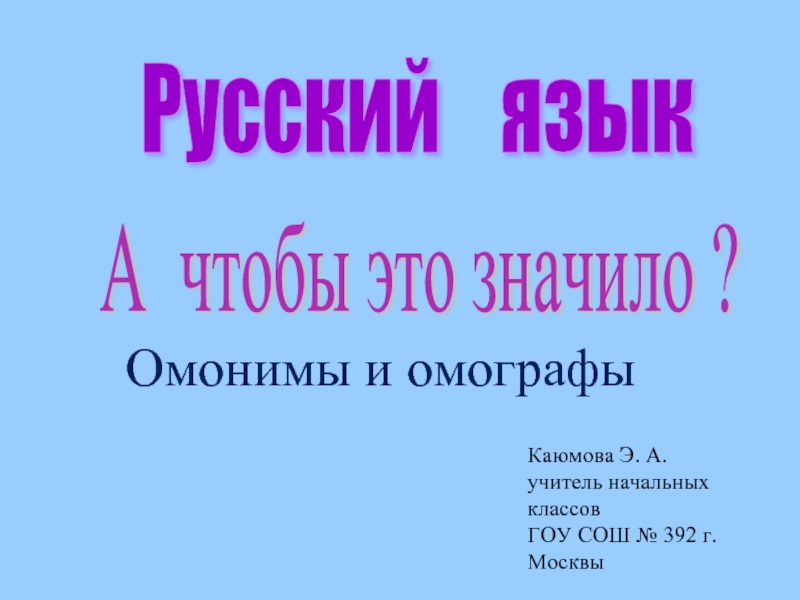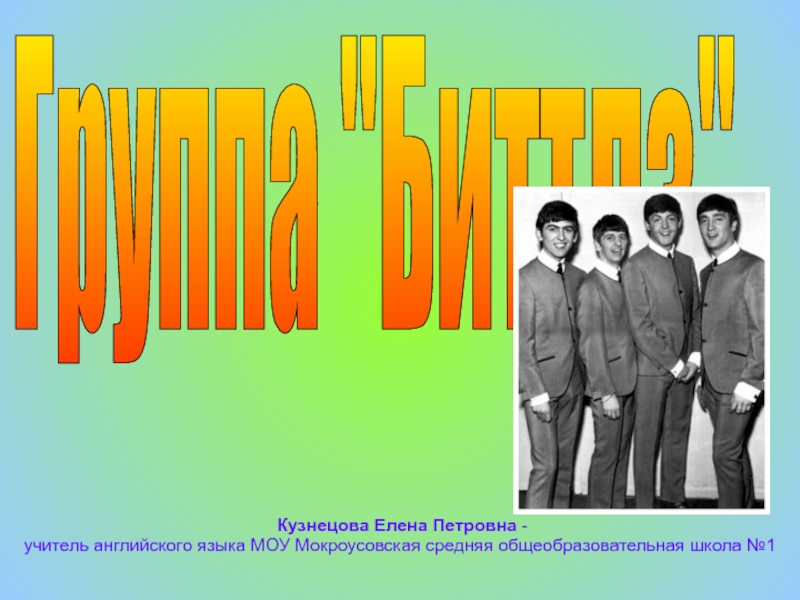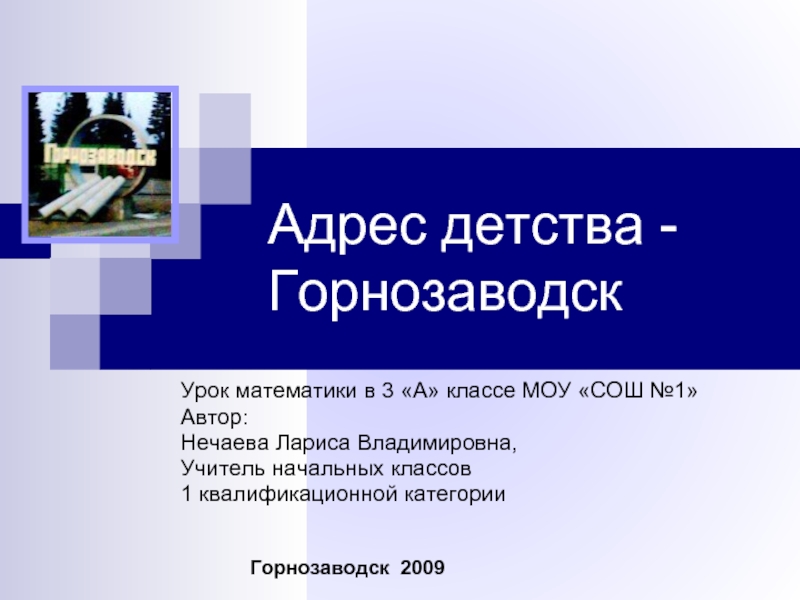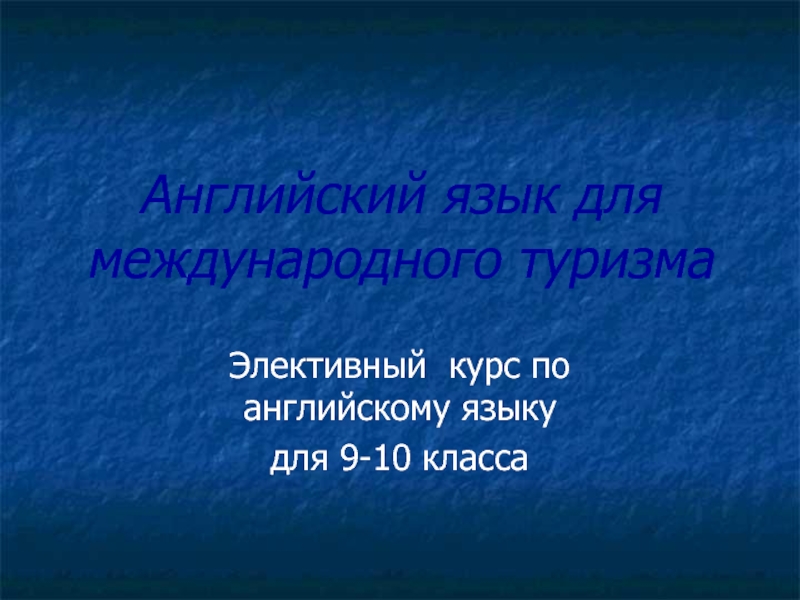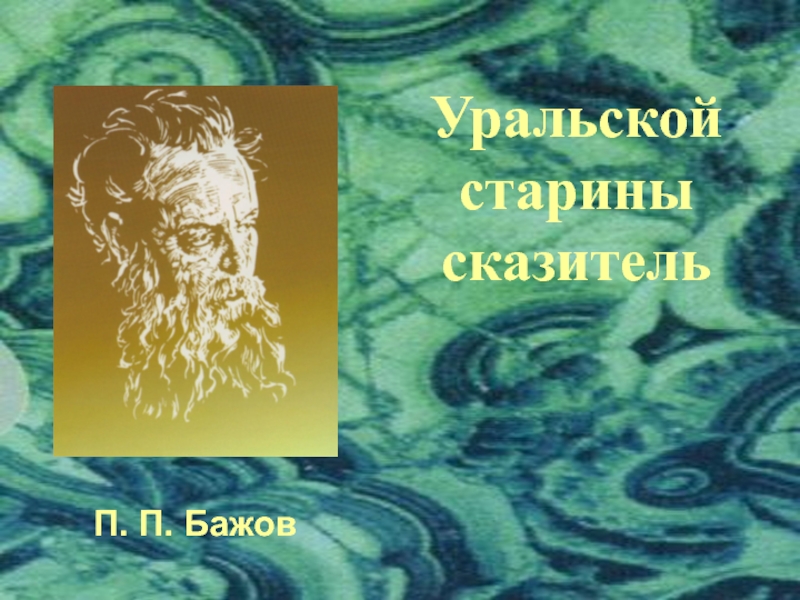- Главная
- Разное
- Дизайн
- Бизнес и предпринимательство
- Аналитика
- Образование
- Развлечения
- Красота и здоровье
- Финансы
- Государство
- Путешествия
- Спорт
- Недвижимость
- Армия
- Графика
- Культурология
- Еда и кулинария
- Лингвистика
- Английский язык
- Астрономия
- Алгебра
- Биология
- География
- Детские презентации
- Информатика
- История
- Литература
- Маркетинг
- Математика
- Медицина
- Менеджмент
- Музыка
- МХК
- Немецкий язык
- ОБЖ
- Обществознание
- Окружающий мир
- Педагогика
- Русский язык
- Технология
- Физика
- Философия
- Химия
- Шаблоны, картинки для презентаций
- Экология
- Экономика
- Юриспруденция
exercise_session_3 презентация
Содержание
- 1. exercise_session_3
- 2. Today We will revisit classes, features and
- 3. Static view A program consists of a
- 4. Dynamic view At runtime we have a
- 5. Static view vs. dynamic view Queries (attributes
- 6. Declaring the type of an object The
- 7. Declaring the type of an object class
- 8. Exercise: Find the classes / objects class
- 9. Exercise: Find the classes / objects feature
- 10. Exercise: Find the classes / objects --
- 11. Who are Adam and Eve? Who creates
- 12. Acrobat game We will play a little
- 13. You are an acrobat When you are
- 14. You are an ACROBAT class ACROBAT
- 15. You are an acrobat with a buddy
- 16. You are an ACROBAT_WITH_BUDDY class ACROBAT_WITH_BUDDY
- 17. You are an ACROBAT_WITH_BUDDY twirl (n: INTEGER)
- 18. You are an author When you are
- 19. You are an AUTHOR class AUTHOR
- 20. You are a curmudgeon When given any
- 21. You are a CURMUDGEON class CURMUDGEON
- 22. I am the root object I got
- 23. I am a DIRECTOR class DIRECTOR
- 24. Let’s play
- 25. I am the root object prepare_and_play local
- 26. Concepts seen
- 27. Concepts seen
- 28. Advanced Material The following slides contain advanced material and are optional.
- 29. Outline Invariants Marriage problems Violating the invariant
- 30. Invariants explained in 60 seconds Consistency requirements
- 31. Public interface of person (without contracts) class
- 32. Write the contracts class PERSON feature spouse:
- 33. A possible solution class PERSON feature spouse:
- 34. Implementing marry class PERSON feature spouse: PERSON
- 35. Implementing marry I class PERSON feature
- 36. class PERSON feature spouse: PERSON
- 37. Implementing marry III class PERSON feature
- 38. Implementing marry : final version class PERSON
- 39. Ending the marriage class PERSON feature spouse:
- 40. Violating the invariant See demo
- 41. What we have seen Invariant should only
Слайд 1Einführung in die Programmierung
Introduction to Programming
Prof. Dr. Bertrand Meyer
Exercise Session 3
Слайд 2Today
We will revisit classes, features and objects.
We will see how program
We will play a game.
Слайд 3Static view
A program consists of a set of classes.
Features are declared
Queries answer questions. They have a result type.
Commands execute actions. They do not have a result type.
Terms “class” and “type” used interchangeably for now.
Слайд 4Dynamic view
At runtime we have a set of objects (instances) constructed
An object has a type that is described in a class.
Objects interact with each other by calling features on each other.
Слайд 5Static view vs. dynamic view
Queries (attributes and functions) have a return
Routines have formal arguments of certain types. During the execution you pass objects as actual arguments in a routine call.
During the execution local variables declared in a routine are objects. They all have certain types.
Слайд 6Declaring the type of an object
The type of any object you
Where can such declarations appear in a program?
in feature declarations
formal argument types
return type for queries
in the local clauses of routines
This is where you declare any objects that only the routine needs and knows.
Слайд 7Declaring the type of an object
class DEMO
feature
procedure_name (a1: T1; a2,
-- Comment
local
l1: T3
do
…
end
function_name (a1: T1; a2, a3: T2): T3
-- Comment
do
…
end
attribute_name: T3
-- Comment
end
formal argument types
local variable types
return type
return type
Слайд 8Exercise: Find the classes / objects
class
game
feature
map_name: string
-- Name of the map
last_player: player
-- Last player that moved
players: player_list
-- List of players in this game.
...
Hands-On
Слайд 9Exercise: Find the classes / objects
feature
is_occupied (a_location: traffic_place): boolean
-- Check
require
a_location_exists: a_location /= Void
local
old_cursor: cursor
do
Result := False
-- Remember old cursor position.
old_cursor := players.cursor
...
Hands-On
Слайд 10Exercise: Find the classes / objects
-- Loop over all players to
-- `a_location'.
from
players.start
-- do not consider estate agent, hence skip the first
-- entry in `players'.
players.forth
until
players.after or Result
loop
if players.item.location = a_location then
Result := True
end
players.forth
end
-- Restore old cursor position.
players.go_to(old_cursor)
end
Hands-On
Слайд 11Who are Adam and Eve?
Who creates the first object? The runtime
The root object creates other objects, which in turn create other objects, etc.
You define the type of the root object in the project settings.
You select a creation procedure of the root object as the first feature to be executed.
Слайд 12Acrobat game
We will play a little game now.
Everyone will be an
There will be different roles.
Hands-On
Слайд 13You are an acrobat
When you are asked to Clap, you will
When you are asked to Twirl, you will be given a number. Turn completely around that many times.
When you are asked for Count, announce how many actions you have performed. This is the sum of the numbers you have been given to date.
Слайд 14You are an ACROBAT
class
ACROBAT
feature
clap (n: INTEGER)
do
-- Clap `n’ times and adjust
end
twirl (n: INTEGER)
do
-- Twirl `n’ times and adjust `count’.
end
count: INTEGER
end
Слайд 15You are an acrobat with a buddy
You will get someone else
When you are asked to Clap, you will be given a number. Clap your hands that many times. Pass the same instruction to your Buddy.
When you are asked to Twirl, you will be given a number. Turn completely around that many times. Pass the same instruction to your Buddy.
If you are asked for Count, ask your Buddy and answer with the number he tells you.
Слайд 16You are an ACROBAT_WITH_BUDDY
class
ACROBAT_WITH_BUDDY
inherit
ACROBAT
redefine
twirl, clap, count
end
create
make
feature
make (p:
do
-- Remember `p’ being the buddy.
end
clap (n: INTEGER)
do
-- Clap `n’ times and forward to buddy.
end
Слайд 17You are an ACROBAT_WITH_BUDDY
twirl (n: INTEGER)
do
-- Twirl `n’ times and forward
end
count: INTEGER
do
-- Ask buddy and return his answer.
end
buddy: ACROBAT
end
Слайд 18You are an author
When you are asked to Clap, you will
When you are asked to Twirl, you will be given a number. Turn completely around that many times. Say “Thank You.” Then take a bow (as dramatically as you like).
When you are asked for Count, announce how many actions you have performed. This is the sum of the numbers you have been given to date.
Слайд 19You are an AUTHOR
class
AUTHOR
inherit
ACROBAT
redefine
clap, twirl
end
feature
clap (n: INTEGER)
do
-- Clap `n’
end
twirl (n: INTEGER)
do
-- Twirl `n’ times say thanks and bow.
end
end
Слайд 20You are a curmudgeon
When given any instruction (Twirl or Clap), ignore
If you are asked for Count, always answer with 0.
Then sit down again if you were originally sitting.
Слайд 21You are a CURMUDGEON
class
CURMUDGEON
inherit
ACROBAT
redefine
clap, twirl
end
feature
clap (n: INTEGER)
do
-- Say “I refuse”.
end
twirl
do
-- Say “I refuse”.
end
end
Слайд 23I am a DIRECTOR
class
DIRECTOR
create
prepare_and_play
feature
prepare_and_play
do
-- See following slides.
end
Слайд 25I am the root object
prepare_and_play
local
acrobat1, acrobat2, acrobat3 : ACROBAT
partner1, partner2: ACROBAT_WITH_BUDDY
author1:
curmudgeon1: CURMUDGEON
do
create acrobat1
create acrobat2
create acrobat3
create partner1.make (acrobat1)
create partner2.make (partner1)
create author1
create curmudgeon1
author1.clap (4)
partner1.twirl (2)
curmudgeon1.clap (7)
acrobat2.clap (curmudgeon1.count)
acrobat3.twirl (partner2.count)
partner1.buddy.clap (partner1.count)
partner2.clap (2)
end
Слайд 30Invariants explained in 60 seconds
Consistency requirements for a class
Established after object
Hold, when an object is visible
Entry of a routine
Exit of a routine
class
ACCOUNT
feature
balance: INTEGER
invariant
balance >= 0
end
Слайд 31Public interface of person (without contracts)
class
PERSON
feature
spouse: PERSON
-- Spouse of Current.
marry (a_other:
-- Marry `a_other’.
end
class
MARRIAGE
feature
make
local
alice: PERSON
bob: PERSON
do
create alice
create bob
bob.marry (alice)
end
end
Слайд 32Write the contracts
class PERSON
feature
spouse: PERSON
marry (a_other: PERSON)
require
??
ensure
??
invariant
??
end
Hands-On
Слайд 33A possible solution
class PERSON
feature
spouse: PERSON
marry (a_other: PERSON)
require
a_other /= Void
a_other.spouse = Void
spouse
ensure
spouse = a_other
a_other.spouse = Current
end
invariant
spouse /= Void implies spouse.spouse = Current
end
Слайд 34Implementing marry
class PERSON
feature
spouse: PERSON
marry (a_other: PERSON)
require
a_other /= Void
a_other.spouse = Void
spouse =
do
??
ensure
spouse = a_other
a_other.spouse = Current
end
invariant
spouse /= Void implies spouse.spouse = Current
end
Слайд 35
Implementing marry I
class PERSON
feature
spouse: PERSON
marry (a_other: PERSON)
require
a_other /= Void
a_other.spouse = Void
spouse
do
a_other.spouse := Current
spouse := a_other
ensure
spouse = a_other
a_other.spouse = Current
end
invariant
spouse /= Void implies spouse.spouse = Current
end
Hands-On
Compiler Error:
No assigner command
Слайд 36
class PERSON
feature
spouse: PERSON
marry (a_other: PERSON)
require
a_other /= Void
a_other.spouse = Void
spouse = Void
do
a_other.set_spouse
spouse := a_other
ensure
spouse = a_other
a_other.spouse = Current
end
set_spouse (a_person: PERSON)
do
spouse := a_person
end
invariant
spouse /= Void implies spouse.spouse = Current
end
Implementing marry II
Hands-On
local
bob, alice: PERSON
do
create bob; create alice
bob.marry (alice)
bob.set_spouse (Void)
-- invariant of alice?
end
Слайд 37
Implementing marry III
class PERSON
feature
spouse: PERSON
marry (a_other: PERSON)
require
a_other /= Void
a_other.spouse = Void
spouse
do
a_other.set_spouse (Current)
spouse := a_other
ensure
spouse = a_other
a_other.spouse = Current
end
feature {PERSON}
set_spouse (a_person: PERSON)
do
spouse := a_person
end
invariant
spouse /= Void implies spouse.spouse = Current
end
Hands-On
Invariant of a_other?
Violated after call to set_spouse
Слайд 38Implementing marry : final version
class PERSON
feature
spouse: PERSON
marry (a_other: PERSON)
require
a_other /= Void
a_other.spouse
spouse = Void
do
spouse := a_other
a_other.set_spouse (Current)
ensure
spouse = a_other
a_other.spouse = Current
end
feature {PERSON}
set_spouse (a_person: PERSON)
do
spouse := a_person
end
invariant
spouse /= Void implies spouse.spouse = Current
end
Слайд 39Ending the marriage
class PERSON
feature
spouse: PERSON
divorce
require
spouse /= Void
do
spouse.set_spouse (Void)
spouse := Void
ensure
spouse =
(old spouse).spouse = Void
end
invariant
spouse /= Void implies spouse.spouse = Current
end
Hands-On
Слайд 41What we have seen
Invariant should only depend on Current object
If invariant
Take care who can change state
Take care in which order you change state
Invariant can be temporarily violated
You can still call features on Current object
Take care calling other objects, they might call back
Although writing invariants is not that easy, they are necessary to do formal proofs. This is also the case for loop invariants (which will come later).

